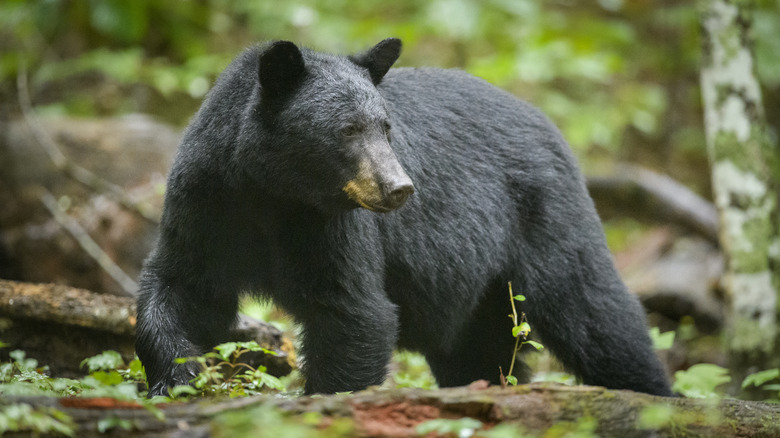How To Easily Tell The Difference Between Grizzly And Black Bears
For anyone spending time outdoors in a large portion of North America, the possibility of encountering dangerous bears is always a concern. North America is home to three such menacing mammals: polar bears, brown bears, and American black bears. The two most common bears in the United States and Canada are brown and black bears. These are also the two most likely to be confused for one another, as the polar bear is very distinguishable by its coloration, which ranges from white to yellowish-white. While distinguishing between brown bears, which are commonly known as grizzlies, and black bears during a chance encounter may seem like a trivial matter, it can actually make a tremendous difference and help you know what to do if attacked by a bear.
For starters, being able to know the difference is only relevant in areas both are known to roam. While black bears are widely distributed and found everywhere grizzlies are located, grizzlies have a much smaller range. So, in much of the United States, the only bear you may encounter are black bears. However, the ranges do overlap in Alaska, Idaho, Montana, and Washington. While there has been speculation they are still present in Colorado, they are believed to have been extirpated since the 1970s and there have been no recent confirmed reports. Their natural range has also diminished in Canada, but grizzlies are still found in many provinces and territories, including Alberta, British Columbia, Northwest Territories, Nunavut, and Yukon.
Don't count on color to tell the difference between brown and black bears
While telling the difference between black bears and brown bears may seem as simple as picking out the right crayon, it can be a bit more complex given that both species have a wide variation in coloration. Although their name suggests otherwise, black bears actually have a full spectrum of fur colors. Black bears can actually be brown or blonde. There are even some reddish and cinnamon-colored black bears. Grizzlies, on the other hand, are not always brown. They may range in color from a light blondish-brown to a deep brown that appears nearly black. Lowlight and shadows can complicate this by making the darker colorations appear even more similar.
Likewise, size can also be a deceptive indicator. While grizzly bears tend to be larger, an adult black bear is about the same size as an adult female or young male grizzly. The same goes for the shoulder height measurement. While a top-end male grizzly stands taller than a black bear, there is a wide overlap in their height ranges. So, like color, size should not be counted on as a definitive way to tell the difference between brown and black bears.
Physical features help tell the difference between these bears
So, how exactly do you tell the difference between bear species that may not be the color their name suggests? You look at their physical features. While size may not be a telltale sign, there are several other distinguishing physical features that can help you easily tell the difference between grizzly and black bears. According to the National Park Service, grizzly bears have a very pronounced shoulder hump, which is one of the quickest ways to distinguish between the two. Grizzlies also have relatively short, rounded ears, while black bears are more of an elongated oval shape. Additionally, a black bear's hind quarters or rump will be higher than its shoulders while walking on all four, while a grizzly's will be lower. Finally, a grizzly bear has a concave face profile. Black bears, on the other hand, have a very straight snout from the tip of their nose to their eyes.
Of course, the best way to stay safe in bear country is to avoid encountering one altogether if possible. To that end, be sure to follow bear safety protocol, avoid mistakes that attract bears, and make noise to avoid bears when hiking. If you do encounter a bear, be alert for bear attack warning signs. For added safety, whenever adventuring in bear territory, it's a good idea to carry and know how to use bear spray.


